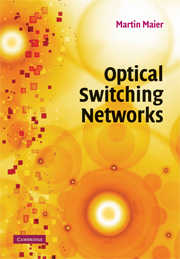Book contents
- Frontmatter
- Contents
- List of illustrations
- List of tables
- Preface
- Acknowledgments
- Part I Introduction
- Part II Optical wide area networks
- Part III Optical metropolitan area networks
- Overview
- 11 Resilient packet ring
- 12 WDM ring networks
- 13 RINGOSTAR
- Part IV Optical access and local area networks
- Part V Testbeds
- Bibliography
- Index
Overview
from Part III - Optical metropolitan area networks
Published online by Cambridge University Press: 10 May 2010
- Frontmatter
- Contents
- List of illustrations
- List of tables
- Preface
- Acknowledgments
- Part I Introduction
- Part II Optical wide area networks
- Part III Optical metropolitan area networks
- Overview
- 11 Resilient packet ring
- 12 WDM ring networks
- 13 RINGOSTAR
- Part IV Optical access and local area networks
- Part V Testbeds
- Bibliography
- Index
Summary
In this part, we explore a wide range of different optical metropolitan area network (MAN) architectures and protocols. MANs are found at the metro level of the network hierarchy between wide area networks (WANs) and access networks. Typically, MANs have a ring topology and are deployed in interconnected ring architectures that are composed of metro core and metro edge rings, as depicted in Fig. III.1. Each metro core ring interconnects several metro edge rings with the long-haul backbone networks. Apart from inter-metro-edge-ring traffic, metro core rings also carry traffic from and to the long-haul backbone networks. Metro edge rings in turn carry traffic between metro core rings and access networks, for example, hybrid fiber coax (HFC), fiber-to-the-home (FTTH), fiber-to-the-building (FTTB) networks, and passive optical networks (PONs). Ring networks offer simplicity in terms of operation, administration, and maintenance (OAM). Moreover, ring networks provide fast protection switching in the event of a single link or node failure.
Optical metro ring networks can be either single-channel or multichannel wavelength division multiplexing (WDM) systems. Optical ring networks were initially singlechannel systems, where each fiber link carries a single wavelength channel (e.g., IEEE 802.5 Token Ring and ANSI Fiber Distributed Data Interface (FDDI)). Optical singlechannel ring networks belong to the first generation of opaque optical networks where OEO conversion takes place at each node. Opaque ring networks have come a long way. Among others, the so-called Cambridge ring is a unidirectional ring network whose channel access is based on the empty-slot principle (Hopper andWilliamson, 1983). The Cambridge ring deploys source stripping, where the source node takes the transmitted packet from the ring.
- Type
- Chapter
- Information
- Optical Switching Networks , pp. 157 - 160Publisher: Cambridge University PressPrint publication year: 2008



